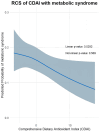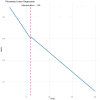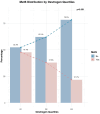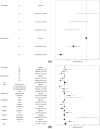Composite dietary antioxidant index is associated with the prevalence of metabolic syndrome in females: results from NHANES 2011-2016
- PMID: 40212720
- PMCID: PMC11983560
- DOI: 10.3389/fnut.2025.1529332
Composite dietary antioxidant index is associated with the prevalence of metabolic syndrome in females: results from NHANES 2011-2016
Abstract
Objective: This study sought to investigate the association between metabolic syndrome (MetS) and Composite Dietary Antioxidant Index (CDAI) in females, with the goal of informing evidence-based prevention and clinical management strategies for MetS.
Methods: The 2011-2016 National Health and Nutrition Examination Survey (NHANES) recruited a total of 2,790 female participants and screened 1,562 participants for estrogen non-deficiency. The diagnosis of MetS was based on criteria set by the National Cholesterol Education Program-Adult Treatment Panel III. The CDAI was calculated according to the intake of 10 dietary antioxidants. Multivariable logistic regression was performed to investigate the relationship between the CDAI and MetS in females. We also performed restricted cubic splines, two-piecewise linear regression, and subgroup analysis in further analysis.
Results: Our analyses demonstrated a significant inverse association between the Composite Dietary Antioxidant Index (CDAI) and metabolic syndrome (MetS) prevalence in females. Restricted cubic spline analysis indicated a linear dose-response relationship (p for linearity = 0.029), with two-piecewise linear regression analysis revealed an inflection point at 1.99. Below 1.99, each unit increase in the CDAI was associated with a 2% reduction in the risk of MetS in females; above 1.99, the risk reduction was 1%. Participants without MetS were significantly younger than those with MetS (43.49 ± 16.04 vs. 54.77 ± 15.52 years, p < 0.001). Notably, estrogen levels also were negatively correlated with the prevalence of MetS. Subgroup analysis revealed that the relationship between the CDAI and MetS remained consistent across all subgroups.
Conclusion: In the female population, CDAI levels exhibited an inverse relationship with the prevalence of metabolic syndrome, and estrogen levels demonstrated a negative correlation with its incidence.
Keywords: CDAI; NHANES; estrogen; females; metabolic syndrome.
Copyright © 2025 Liu, Xu, Xiao, Li and Liu.
Conflict of interest statement
The authors declare that the research was conducted in the absence of any commercial or financial relationships that could be construed as a potential conflict of interest.
Figures






References
-
- Gupta A, Gupta V. Metabolic syndrome: what are the risks for humans? Biosci Trends. (2010) 4:204–12. PMID: - PubMed
-
- Cano-Ibáñez N, Gea A, Martínez-González MA, Salas-Salvadó J, Corella D, Zomeño MD, et al. . Dietary diversity and nutritional adequacy among an older Spanish population with metabolic syndrome in the Predimed-plus study: a cross-sectional analysis. Nutrients. (2019) 11:958. doi: 10.3390/nu11050958, PMID: - DOI - PMC - PubMed
-
- Delavari A, Forouzanfar MH, Alikhani S, Sharifian A, Kelishadi R. First nationwide study of the prevalence of the metabolic syndrome and optimal cutoff points of waist circumference in the Middle East: the national survey of risk factors for noncommunicable diseases of Iran. Diabetes Care. (2009) 32:1092–7. doi: 10.2337/dc08-1800, PMID: - DOI - PMC - PubMed
LinkOut - more resources
Full Text Sources

